FIN5003 Financial Control and Budgeting Report - Semester 1
VerifiedAdded on 2022/11/30
|17
|5162
|322
Report
AI Summary
This report provides a comprehensive analysis of financial control and budgeting within the health and social care sector. It begins by examining the legal, financial, and regulatory environments impacting operations, including relevant legislation and regulatory bodies. The report then evaluates various funding options, such as private finance initiatives and agency partnerships, and discusses the agency theory's role in fostering communication with stakeholders. The main body delves into the impact of financial constraints, costs, and budgets on health and social care managers, clients, and stakeholders. It also addresses the challenges of budgeting in public sector organizations, and compares incremental and zero-based budgeting. Furthermore, the report includes a break-even analysis, calculating the break-even point and margin of safety, and outlining the underlying assumptions of the break-even model. Overall, the report offers valuable insights into the financial aspects of the health and social care sector.
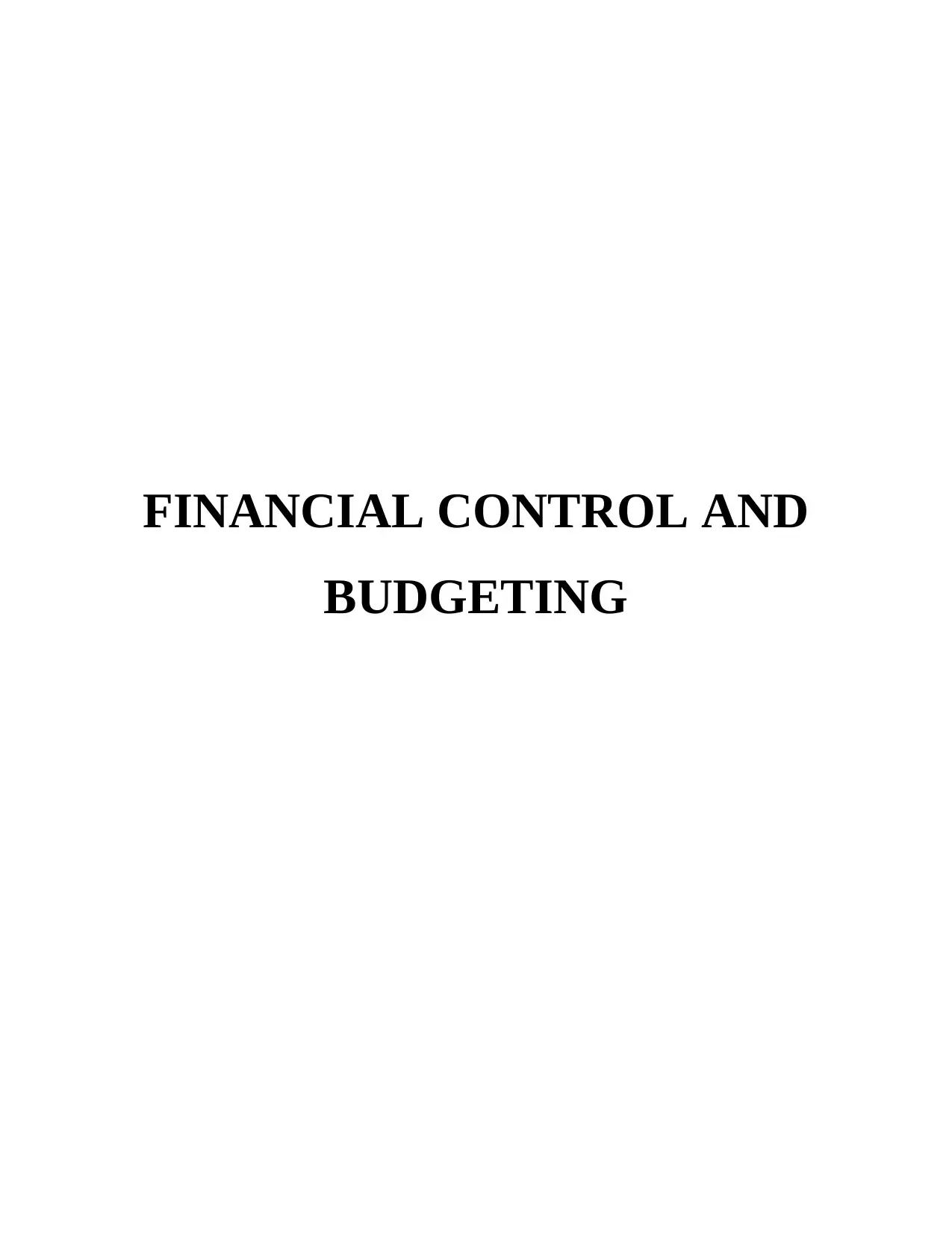
FINANCIAL CONTROL AND
BUDGETING
BUDGETING
Paraphrase This Document
Need a fresh take? Get an instant paraphrase of this document with our AI Paraphraser
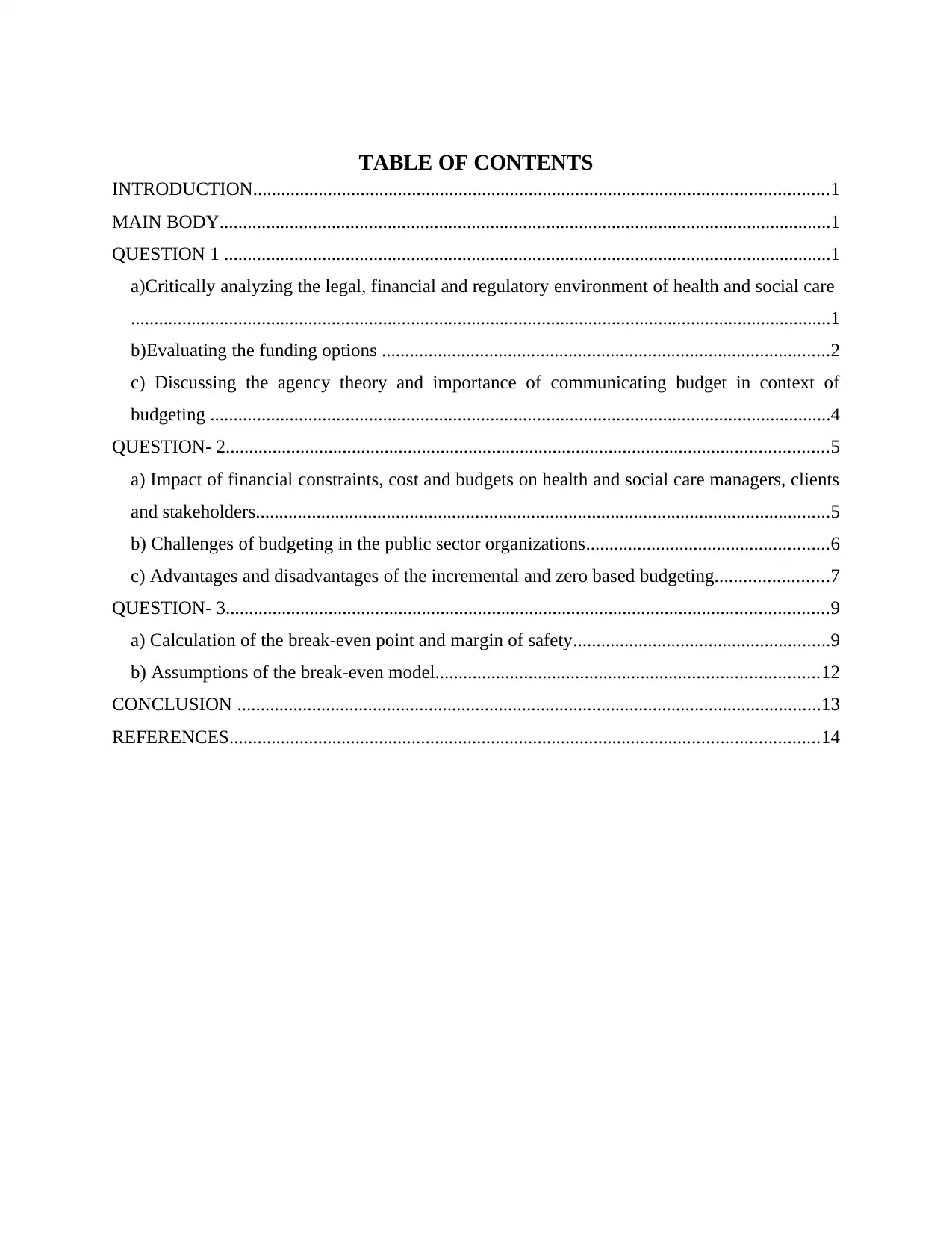
TABLE OF CONTENTS
INTRODUCTION...........................................................................................................................1
MAIN BODY...................................................................................................................................1
QUESTION 1 ..................................................................................................................................1
a)Critically analyzing the legal, financial and regulatory environment of health and social care
......................................................................................................................................................1
b)Evaluating the funding options ................................................................................................2
c) Discussing the agency theory and importance of communicating budget in context of
budgeting .....................................................................................................................................4
QUESTION- 2.................................................................................................................................5
a) Impact of financial constraints, cost and budgets on health and social care managers, clients
and stakeholders...........................................................................................................................5
b) Challenges of budgeting in the public sector organizations....................................................6
c) Advantages and disadvantages of the incremental and zero based budgeting........................7
QUESTION- 3.................................................................................................................................9
a) Calculation of the break-even point and margin of safety.......................................................9
b) Assumptions of the break-even model..................................................................................12
CONCLUSION .............................................................................................................................13
REFERENCES..............................................................................................................................14
INTRODUCTION...........................................................................................................................1
MAIN BODY...................................................................................................................................1
QUESTION 1 ..................................................................................................................................1
a)Critically analyzing the legal, financial and regulatory environment of health and social care
......................................................................................................................................................1
b)Evaluating the funding options ................................................................................................2
c) Discussing the agency theory and importance of communicating budget in context of
budgeting .....................................................................................................................................4
QUESTION- 2.................................................................................................................................5
a) Impact of financial constraints, cost and budgets on health and social care managers, clients
and stakeholders...........................................................................................................................5
b) Challenges of budgeting in the public sector organizations....................................................6
c) Advantages and disadvantages of the incremental and zero based budgeting........................7
QUESTION- 3.................................................................................................................................9
a) Calculation of the break-even point and margin of safety.......................................................9
b) Assumptions of the break-even model..................................................................................12
CONCLUSION .............................................................................................................................13
REFERENCES..............................................................................................................................14
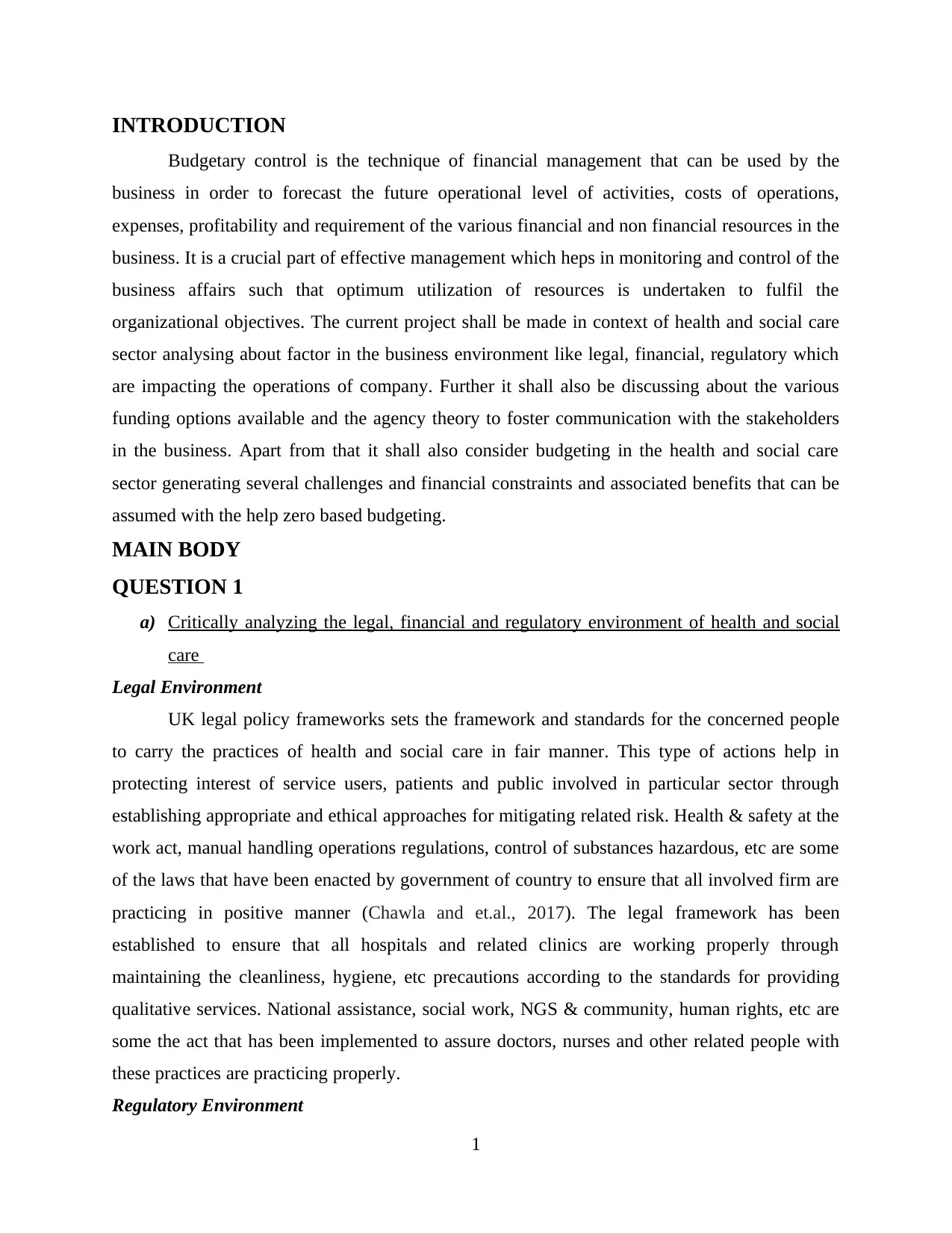
INTRODUCTION
Budgetary control is the technique of financial management that can be used by the
business in order to forecast the future operational level of activities, costs of operations,
expenses, profitability and requirement of the various financial and non financial resources in the
business. It is a crucial part of effective management which heps in monitoring and control of the
business affairs such that optimum utilization of resources is undertaken to fulfil the
organizational objectives. The current project shall be made in context of health and social care
sector analysing about factor in the business environment like legal, financial, regulatory which
are impacting the operations of company. Further it shall also be discussing about the various
funding options available and the agency theory to foster communication with the stakeholders
in the business. Apart from that it shall also consider budgeting in the health and social care
sector generating several challenges and financial constraints and associated benefits that can be
assumed with the help zero based budgeting.
MAIN BODY
QUESTION 1
a) Critically analyzing the legal, financial and regulatory environment of health and social
care
Legal Environment
UK legal policy frameworks sets the framework and standards for the concerned people
to carry the practices of health and social care in fair manner. This type of actions help in
protecting interest of service users, patients and public involved in particular sector through
establishing appropriate and ethical approaches for mitigating related risk. Health & safety at the
work act, manual handling operations regulations, control of substances hazardous, etc are some
of the laws that have been enacted by government of country to ensure that all involved firm are
practicing in positive manner (Chawla and et.al., 2017). The legal framework has been
established to ensure that all hospitals and related clinics are working properly through
maintaining the cleanliness, hygiene, etc precautions according to the standards for providing
qualitative services. National assistance, social work, NGS & community, human rights, etc are
some the act that has been implemented to assure doctors, nurses and other related people with
these practices are practicing properly.
Regulatory Environment
1
Budgetary control is the technique of financial management that can be used by the
business in order to forecast the future operational level of activities, costs of operations,
expenses, profitability and requirement of the various financial and non financial resources in the
business. It is a crucial part of effective management which heps in monitoring and control of the
business affairs such that optimum utilization of resources is undertaken to fulfil the
organizational objectives. The current project shall be made in context of health and social care
sector analysing about factor in the business environment like legal, financial, regulatory which
are impacting the operations of company. Further it shall also be discussing about the various
funding options available and the agency theory to foster communication with the stakeholders
in the business. Apart from that it shall also consider budgeting in the health and social care
sector generating several challenges and financial constraints and associated benefits that can be
assumed with the help zero based budgeting.
MAIN BODY
QUESTION 1
a) Critically analyzing the legal, financial and regulatory environment of health and social
care
Legal Environment
UK legal policy frameworks sets the framework and standards for the concerned people
to carry the practices of health and social care in fair manner. This type of actions help in
protecting interest of service users, patients and public involved in particular sector through
establishing appropriate and ethical approaches for mitigating related risk. Health & safety at the
work act, manual handling operations regulations, control of substances hazardous, etc are some
of the laws that have been enacted by government of country to ensure that all involved firm are
practicing in positive manner (Chawla and et.al., 2017). The legal framework has been
established to ensure that all hospitals and related clinics are working properly through
maintaining the cleanliness, hygiene, etc precautions according to the standards for providing
qualitative services. National assistance, social work, NGS & community, human rights, etc are
some the act that has been implemented to assure doctors, nurses and other related people with
these practices are practicing properly.
Regulatory Environment
1
⊘ This is a preview!⊘
Do you want full access?
Subscribe today to unlock all pages.

Trusted by 1+ million students worldwide
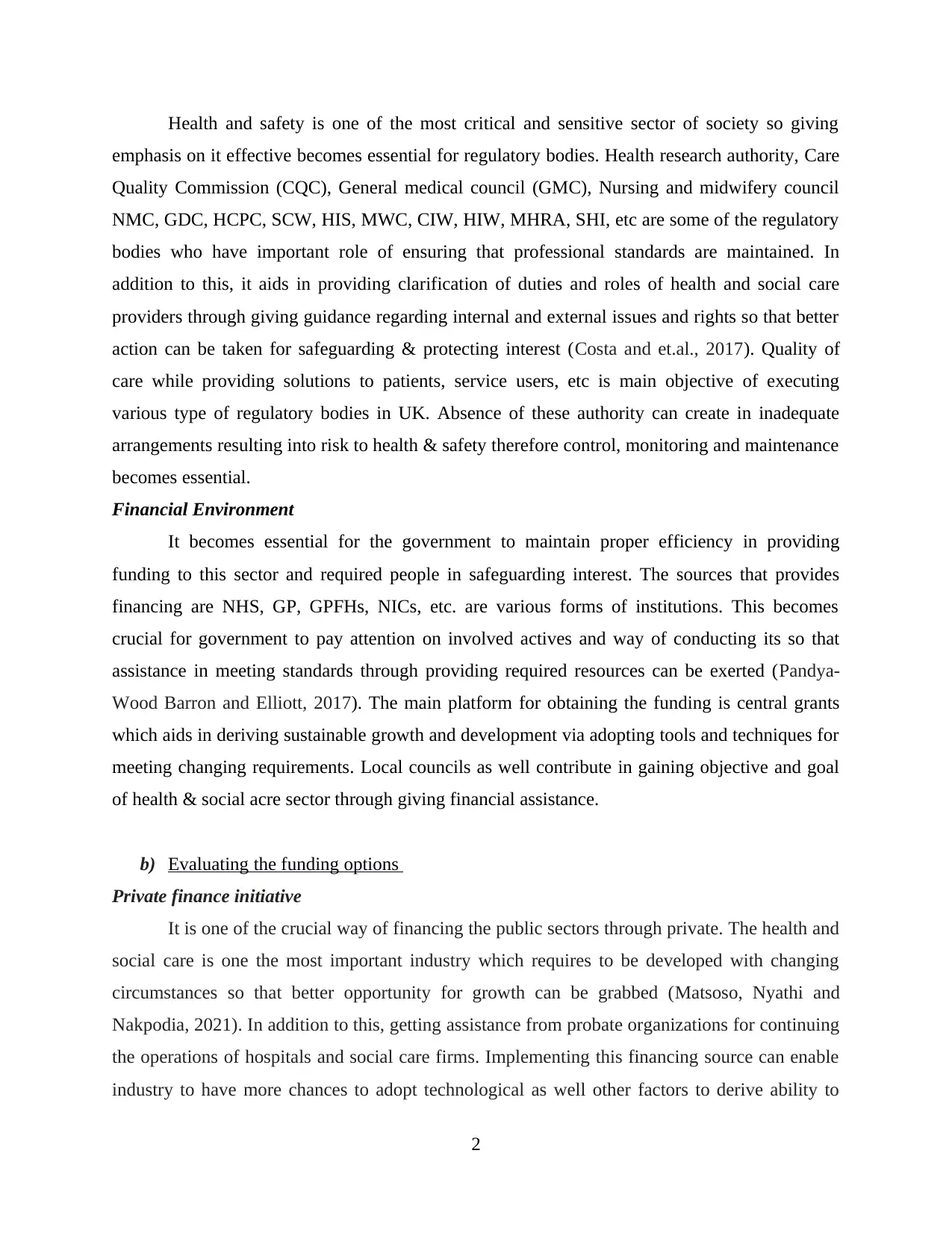
Health and safety is one of the most critical and sensitive sector of society so giving
emphasis on it effective becomes essential for regulatory bodies. Health research authority, Care
Quality Commission (CQC), General medical council (GMC), Nursing and midwifery council
NMC, GDC, HCPC, SCW, HIS, MWC, CIW, HIW, MHRA, SHI, etc are some of the regulatory
bodies who have important role of ensuring that professional standards are maintained. In
addition to this, it aids in providing clarification of duties and roles of health and social care
providers through giving guidance regarding internal and external issues and rights so that better
action can be taken for safeguarding & protecting interest (Costa and et.al., 2017). Quality of
care while providing solutions to patients, service users, etc is main objective of executing
various type of regulatory bodies in UK. Absence of these authority can create in inadequate
arrangements resulting into risk to health & safety therefore control, monitoring and maintenance
becomes essential.
Financial Environment
It becomes essential for the government to maintain proper efficiency in providing
funding to this sector and required people in safeguarding interest. The sources that provides
financing are NHS, GP, GPFHs, NICs, etc. are various forms of institutions. This becomes
crucial for government to pay attention on involved actives and way of conducting its so that
assistance in meeting standards through providing required resources can be exerted (Pandya-
Wood Barron and Elliott, 2017). The main platform for obtaining the funding is central grants
which aids in deriving sustainable growth and development via adopting tools and techniques for
meeting changing requirements. Local councils as well contribute in gaining objective and goal
of health & social acre sector through giving financial assistance.
b) Evaluating the funding options
Private finance initiative
It is one of the crucial way of financing the public sectors through private. The health and
social care is one the most important industry which requires to be developed with changing
circumstances so that better opportunity for growth can be grabbed (Matsoso, Nyathi and
Nakpodia, 2021). In addition to this, getting assistance from probate organizations for continuing
the operations of hospitals and social care firms. Implementing this financing source can enable
industry to have more chances to adopt technological as well other factors to derive ability to
2
emphasis on it effective becomes essential for regulatory bodies. Health research authority, Care
Quality Commission (CQC), General medical council (GMC), Nursing and midwifery council
NMC, GDC, HCPC, SCW, HIS, MWC, CIW, HIW, MHRA, SHI, etc are some of the regulatory
bodies who have important role of ensuring that professional standards are maintained. In
addition to this, it aids in providing clarification of duties and roles of health and social care
providers through giving guidance regarding internal and external issues and rights so that better
action can be taken for safeguarding & protecting interest (Costa and et.al., 2017). Quality of
care while providing solutions to patients, service users, etc is main objective of executing
various type of regulatory bodies in UK. Absence of these authority can create in inadequate
arrangements resulting into risk to health & safety therefore control, monitoring and maintenance
becomes essential.
Financial Environment
It becomes essential for the government to maintain proper efficiency in providing
funding to this sector and required people in safeguarding interest. The sources that provides
financing are NHS, GP, GPFHs, NICs, etc. are various forms of institutions. This becomes
crucial for government to pay attention on involved actives and way of conducting its so that
assistance in meeting standards through providing required resources can be exerted (Pandya-
Wood Barron and Elliott, 2017). The main platform for obtaining the funding is central grants
which aids in deriving sustainable growth and development via adopting tools and techniques for
meeting changing requirements. Local councils as well contribute in gaining objective and goal
of health & social acre sector through giving financial assistance.
b) Evaluating the funding options
Private finance initiative
It is one of the crucial way of financing the public sectors through private. The health and
social care is one the most important industry which requires to be developed with changing
circumstances so that better opportunity for growth can be grabbed (Matsoso, Nyathi and
Nakpodia, 2021). In addition to this, getting assistance from probate organizations for continuing
the operations of hospitals and social care firms. Implementing this financing source can enable
industry to have more chances to adopt technological as well other factors to derive ability to
2
Paraphrase This Document
Need a fresh take? Get an instant paraphrase of this document with our AI Paraphraser
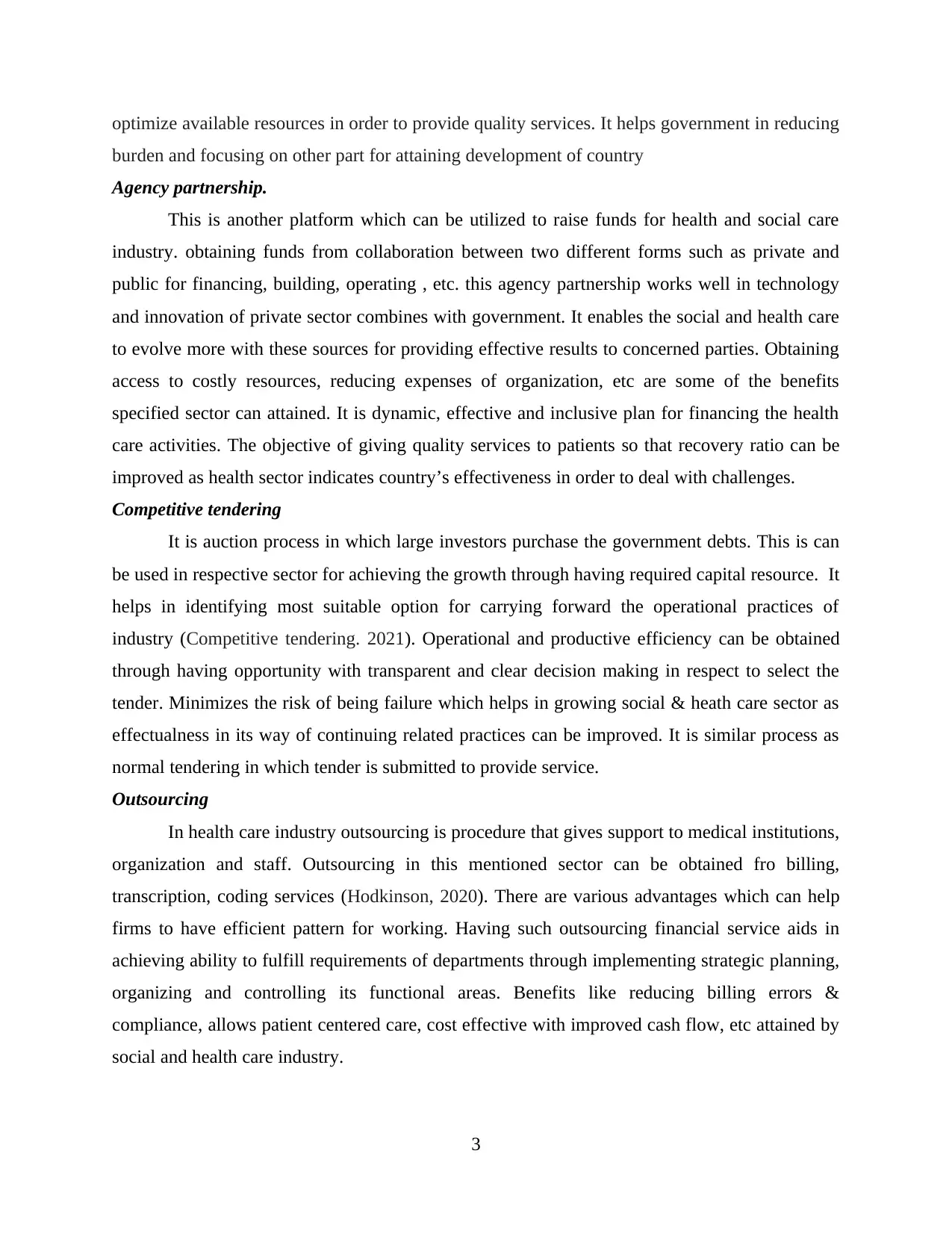
optimize available resources in order to provide quality services. It helps government in reducing
burden and focusing on other part for attaining development of country
Agency partnership.
This is another platform which can be utilized to raise funds for health and social care
industry. obtaining funds from collaboration between two different forms such as private and
public for financing, building, operating , etc. this agency partnership works well in technology
and innovation of private sector combines with government. It enables the social and health care
to evolve more with these sources for providing effective results to concerned parties. Obtaining
access to costly resources, reducing expenses of organization, etc are some of the benefits
specified sector can attained. It is dynamic, effective and inclusive plan for financing the health
care activities. The objective of giving quality services to patients so that recovery ratio can be
improved as health sector indicates country’s effectiveness in order to deal with challenges.
Competitive tendering
It is auction process in which large investors purchase the government debts. This is can
be used in respective sector for achieving the growth through having required capital resource. It
helps in identifying most suitable option for carrying forward the operational practices of
industry (Competitive tendering. 2021). Operational and productive efficiency can be obtained
through having opportunity with transparent and clear decision making in respect to select the
tender. Minimizes the risk of being failure which helps in growing social & heath care sector as
effectualness in its way of continuing related practices can be improved. It is similar process as
normal tendering in which tender is submitted to provide service.
Outsourcing
In health care industry outsourcing is procedure that gives support to medical institutions,
organization and staff. Outsourcing in this mentioned sector can be obtained fro billing,
transcription, coding services (Hodkinson, 2020). There are various advantages which can help
firms to have efficient pattern for working. Having such outsourcing financial service aids in
achieving ability to fulfill requirements of departments through implementing strategic planning,
organizing and controlling its functional areas. Benefits like reducing billing errors &
compliance, allows patient centered care, cost effective with improved cash flow, etc attained by
social and health care industry.
3
burden and focusing on other part for attaining development of country
Agency partnership.
This is another platform which can be utilized to raise funds for health and social care
industry. obtaining funds from collaboration between two different forms such as private and
public for financing, building, operating , etc. this agency partnership works well in technology
and innovation of private sector combines with government. It enables the social and health care
to evolve more with these sources for providing effective results to concerned parties. Obtaining
access to costly resources, reducing expenses of organization, etc are some of the benefits
specified sector can attained. It is dynamic, effective and inclusive plan for financing the health
care activities. The objective of giving quality services to patients so that recovery ratio can be
improved as health sector indicates country’s effectiveness in order to deal with challenges.
Competitive tendering
It is auction process in which large investors purchase the government debts. This is can
be used in respective sector for achieving the growth through having required capital resource. It
helps in identifying most suitable option for carrying forward the operational practices of
industry (Competitive tendering. 2021). Operational and productive efficiency can be obtained
through having opportunity with transparent and clear decision making in respect to select the
tender. Minimizes the risk of being failure which helps in growing social & heath care sector as
effectualness in its way of continuing related practices can be improved. It is similar process as
normal tendering in which tender is submitted to provide service.
Outsourcing
In health care industry outsourcing is procedure that gives support to medical institutions,
organization and staff. Outsourcing in this mentioned sector can be obtained fro billing,
transcription, coding services (Hodkinson, 2020). There are various advantages which can help
firms to have efficient pattern for working. Having such outsourcing financial service aids in
achieving ability to fulfill requirements of departments through implementing strategic planning,
organizing and controlling its functional areas. Benefits like reducing billing errors &
compliance, allows patient centered care, cost effective with improved cash flow, etc attained by
social and health care industry.
3
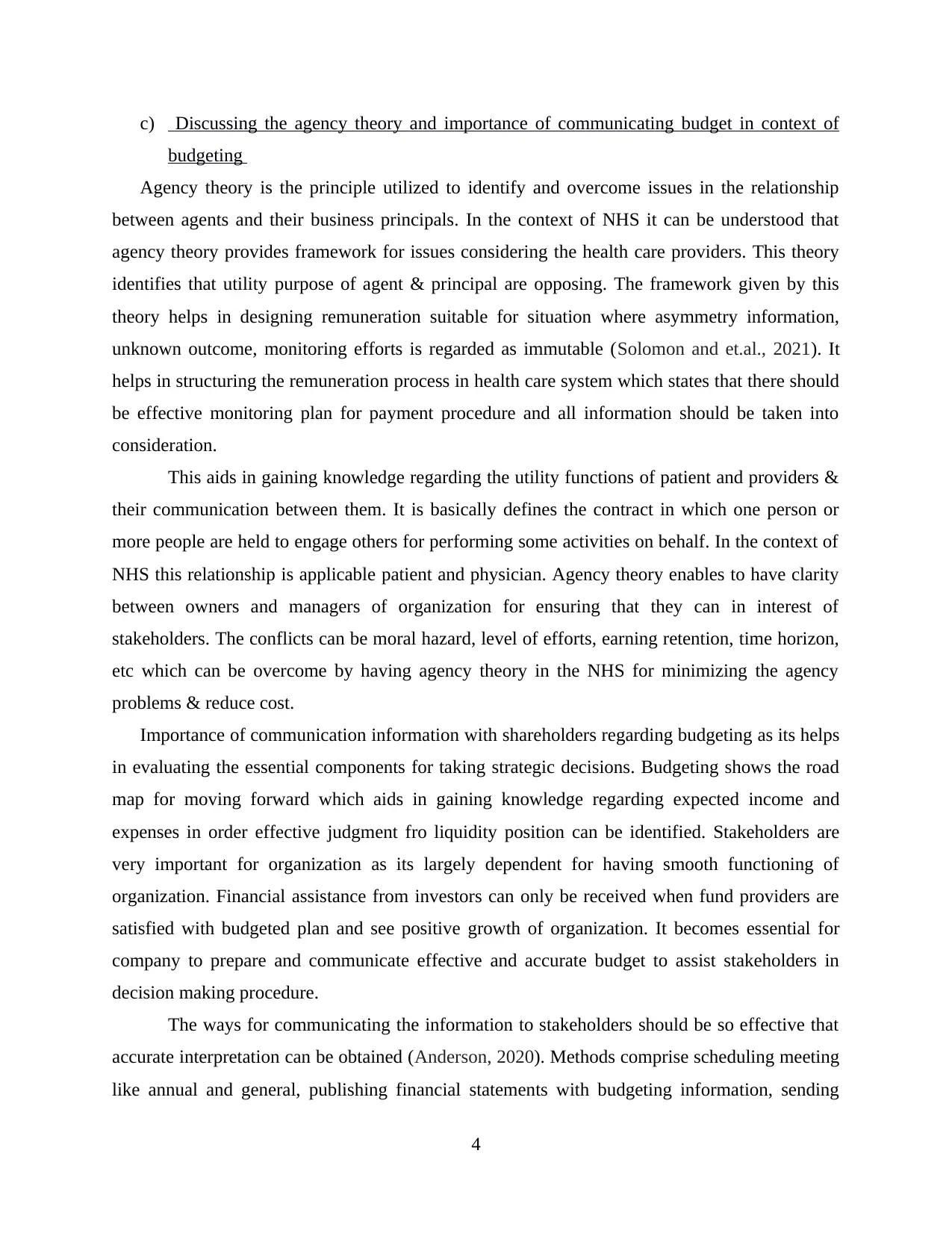
c) Discussing the agency theory and importance of communicating budget in context of
budgeting
Agency theory is the principle utilized to identify and overcome issues in the relationship
between agents and their business principals. In the context of NHS it can be understood that
agency theory provides framework for issues considering the health care providers. This theory
identifies that utility purpose of agent & principal are opposing. The framework given by this
theory helps in designing remuneration suitable for situation where asymmetry information,
unknown outcome, monitoring efforts is regarded as immutable (Solomon and et.al., 2021). It
helps in structuring the remuneration process in health care system which states that there should
be effective monitoring plan for payment procedure and all information should be taken into
consideration.
This aids in gaining knowledge regarding the utility functions of patient and providers &
their communication between them. It is basically defines the contract in which one person or
more people are held to engage others for performing some activities on behalf. In the context of
NHS this relationship is applicable patient and physician. Agency theory enables to have clarity
between owners and managers of organization for ensuring that they can in interest of
stakeholders. The conflicts can be moral hazard, level of efforts, earning retention, time horizon,
etc which can be overcome by having agency theory in the NHS for minimizing the agency
problems & reduce cost.
Importance of communication information with shareholders regarding budgeting as its helps
in evaluating the essential components for taking strategic decisions. Budgeting shows the road
map for moving forward which aids in gaining knowledge regarding expected income and
expenses in order effective judgment fro liquidity position can be identified. Stakeholders are
very important for organization as its largely dependent for having smooth functioning of
organization. Financial assistance from investors can only be received when fund providers are
satisfied with budgeted plan and see positive growth of organization. It becomes essential for
company to prepare and communicate effective and accurate budget to assist stakeholders in
decision making procedure.
The ways for communicating the information to stakeholders should be so effective that
accurate interpretation can be obtained (Anderson, 2020). Methods comprise scheduling meeting
like annual and general, publishing financial statements with budgeting information, sending
4
budgeting
Agency theory is the principle utilized to identify and overcome issues in the relationship
between agents and their business principals. In the context of NHS it can be understood that
agency theory provides framework for issues considering the health care providers. This theory
identifies that utility purpose of agent & principal are opposing. The framework given by this
theory helps in designing remuneration suitable for situation where asymmetry information,
unknown outcome, monitoring efforts is regarded as immutable (Solomon and et.al., 2021). It
helps in structuring the remuneration process in health care system which states that there should
be effective monitoring plan for payment procedure and all information should be taken into
consideration.
This aids in gaining knowledge regarding the utility functions of patient and providers &
their communication between them. It is basically defines the contract in which one person or
more people are held to engage others for performing some activities on behalf. In the context of
NHS this relationship is applicable patient and physician. Agency theory enables to have clarity
between owners and managers of organization for ensuring that they can in interest of
stakeholders. The conflicts can be moral hazard, level of efforts, earning retention, time horizon,
etc which can be overcome by having agency theory in the NHS for minimizing the agency
problems & reduce cost.
Importance of communication information with shareholders regarding budgeting as its helps
in evaluating the essential components for taking strategic decisions. Budgeting shows the road
map for moving forward which aids in gaining knowledge regarding expected income and
expenses in order effective judgment fro liquidity position can be identified. Stakeholders are
very important for organization as its largely dependent for having smooth functioning of
organization. Financial assistance from investors can only be received when fund providers are
satisfied with budgeted plan and see positive growth of organization. It becomes essential for
company to prepare and communicate effective and accurate budget to assist stakeholders in
decision making procedure.
The ways for communicating the information to stakeholders should be so effective that
accurate interpretation can be obtained (Anderson, 2020). Methods comprise scheduling meeting
like annual and general, publishing financial statements with budgeting information, sending
4
⊘ This is a preview!⊘
Do you want full access?
Subscribe today to unlock all pages.

Trusted by 1+ million students worldwide
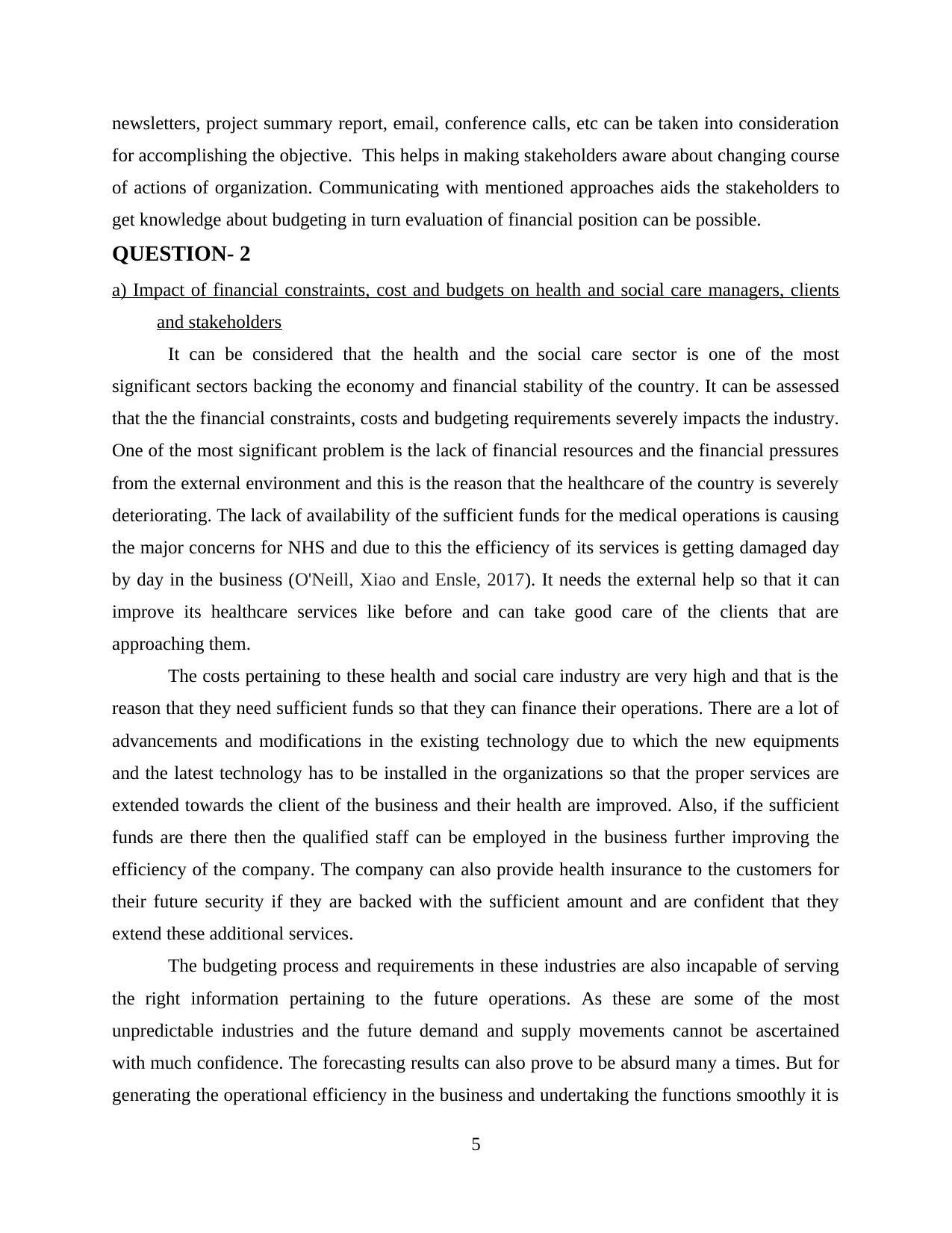
newsletters, project summary report, email, conference calls, etc can be taken into consideration
for accomplishing the objective. This helps in making stakeholders aware about changing course
of actions of organization. Communicating with mentioned approaches aids the stakeholders to
get knowledge about budgeting in turn evaluation of financial position can be possible.
QUESTION- 2
a) Impact of financial constraints, cost and budgets on health and social care managers, clients
and stakeholders
It can be considered that the health and the social care sector is one of the most
significant sectors backing the economy and financial stability of the country. It can be assessed
that the the financial constraints, costs and budgeting requirements severely impacts the industry.
One of the most significant problem is the lack of financial resources and the financial pressures
from the external environment and this is the reason that the healthcare of the country is severely
deteriorating. The lack of availability of the sufficient funds for the medical operations is causing
the major concerns for NHS and due to this the efficiency of its services is getting damaged day
by day in the business (O'Neill, Xiao and Ensle, 2017). It needs the external help so that it can
improve its healthcare services like before and can take good care of the clients that are
approaching them.
The costs pertaining to these health and social care industry are very high and that is the
reason that they need sufficient funds so that they can finance their operations. There are a lot of
advancements and modifications in the existing technology due to which the new equipments
and the latest technology has to be installed in the organizations so that the proper services are
extended towards the client of the business and their health are improved. Also, if the sufficient
funds are there then the qualified staff can be employed in the business further improving the
efficiency of the company. The company can also provide health insurance to the customers for
their future security if they are backed with the sufficient amount and are confident that they
extend these additional services.
The budgeting process and requirements in these industries are also incapable of serving
the right information pertaining to the future operations. As these are some of the most
unpredictable industries and the future demand and supply movements cannot be ascertained
with much confidence. The forecasting results can also prove to be absurd many a times. But for
generating the operational efficiency in the business and undertaking the functions smoothly it is
5
for accomplishing the objective. This helps in making stakeholders aware about changing course
of actions of organization. Communicating with mentioned approaches aids the stakeholders to
get knowledge about budgeting in turn evaluation of financial position can be possible.
QUESTION- 2
a) Impact of financial constraints, cost and budgets on health and social care managers, clients
and stakeholders
It can be considered that the health and the social care sector is one of the most
significant sectors backing the economy and financial stability of the country. It can be assessed
that the the financial constraints, costs and budgeting requirements severely impacts the industry.
One of the most significant problem is the lack of financial resources and the financial pressures
from the external environment and this is the reason that the healthcare of the country is severely
deteriorating. The lack of availability of the sufficient funds for the medical operations is causing
the major concerns for NHS and due to this the efficiency of its services is getting damaged day
by day in the business (O'Neill, Xiao and Ensle, 2017). It needs the external help so that it can
improve its healthcare services like before and can take good care of the clients that are
approaching them.
The costs pertaining to these health and social care industry are very high and that is the
reason that they need sufficient funds so that they can finance their operations. There are a lot of
advancements and modifications in the existing technology due to which the new equipments
and the latest technology has to be installed in the organizations so that the proper services are
extended towards the client of the business and their health are improved. Also, if the sufficient
funds are there then the qualified staff can be employed in the business further improving the
efficiency of the company. The company can also provide health insurance to the customers for
their future security if they are backed with the sufficient amount and are confident that they
extend these additional services.
The budgeting process and requirements in these industries are also incapable of serving
the right information pertaining to the future operations. As these are some of the most
unpredictable industries and the future demand and supply movements cannot be ascertained
with much confidence. The forecasting results can also prove to be absurd many a times. But for
generating the operational efficiency in the business and undertaking the functions smoothly it is
5
Paraphrase This Document
Need a fresh take? Get an instant paraphrase of this document with our AI Paraphraser
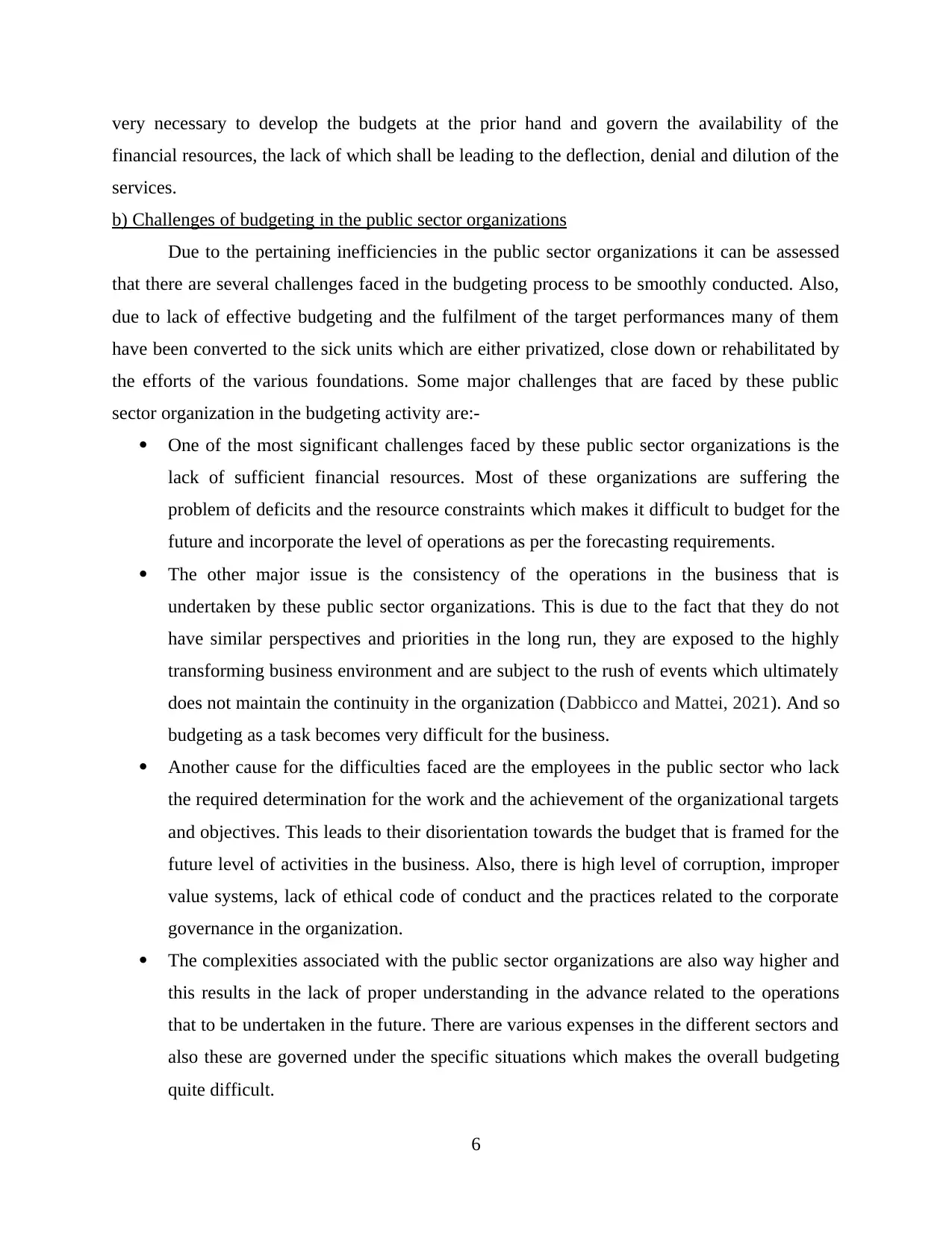
very necessary to develop the budgets at the prior hand and govern the availability of the
financial resources, the lack of which shall be leading to the deflection, denial and dilution of the
services.
b) Challenges of budgeting in the public sector organizations
Due to the pertaining inefficiencies in the public sector organizations it can be assessed
that there are several challenges faced in the budgeting process to be smoothly conducted. Also,
due to lack of effective budgeting and the fulfilment of the target performances many of them
have been converted to the sick units which are either privatized, close down or rehabilitated by
the efforts of the various foundations. Some major challenges that are faced by these public
sector organization in the budgeting activity are:-
One of the most significant challenges faced by these public sector organizations is the
lack of sufficient financial resources. Most of these organizations are suffering the
problem of deficits and the resource constraints which makes it difficult to budget for the
future and incorporate the level of operations as per the forecasting requirements.
The other major issue is the consistency of the operations in the business that is
undertaken by these public sector organizations. This is due to the fact that they do not
have similar perspectives and priorities in the long run, they are exposed to the highly
transforming business environment and are subject to the rush of events which ultimately
does not maintain the continuity in the organization (Dabbicco and Mattei, 2021). And so
budgeting as a task becomes very difficult for the business.
Another cause for the difficulties faced are the employees in the public sector who lack
the required determination for the work and the achievement of the organizational targets
and objectives. This leads to their disorientation towards the budget that is framed for the
future level of activities in the business. Also, there is high level of corruption, improper
value systems, lack of ethical code of conduct and the practices related to the corporate
governance in the organization.
The complexities associated with the public sector organizations are also way higher and
this results in the lack of proper understanding in the advance related to the operations
that to be undertaken in the future. There are various expenses in the different sectors and
also these are governed under the specific situations which makes the overall budgeting
quite difficult.
6
financial resources, the lack of which shall be leading to the deflection, denial and dilution of the
services.
b) Challenges of budgeting in the public sector organizations
Due to the pertaining inefficiencies in the public sector organizations it can be assessed
that there are several challenges faced in the budgeting process to be smoothly conducted. Also,
due to lack of effective budgeting and the fulfilment of the target performances many of them
have been converted to the sick units which are either privatized, close down or rehabilitated by
the efforts of the various foundations. Some major challenges that are faced by these public
sector organization in the budgeting activity are:-
One of the most significant challenges faced by these public sector organizations is the
lack of sufficient financial resources. Most of these organizations are suffering the
problem of deficits and the resource constraints which makes it difficult to budget for the
future and incorporate the level of operations as per the forecasting requirements.
The other major issue is the consistency of the operations in the business that is
undertaken by these public sector organizations. This is due to the fact that they do not
have similar perspectives and priorities in the long run, they are exposed to the highly
transforming business environment and are subject to the rush of events which ultimately
does not maintain the continuity in the organization (Dabbicco and Mattei, 2021). And so
budgeting as a task becomes very difficult for the business.
Another cause for the difficulties faced are the employees in the public sector who lack
the required determination for the work and the achievement of the organizational targets
and objectives. This leads to their disorientation towards the budget that is framed for the
future level of activities in the business. Also, there is high level of corruption, improper
value systems, lack of ethical code of conduct and the practices related to the corporate
governance in the organization.
The complexities associated with the public sector organizations are also way higher and
this results in the lack of proper understanding in the advance related to the operations
that to be undertaken in the future. There are various expenses in the different sectors and
also these are governed under the specific situations which makes the overall budgeting
quite difficult.
6
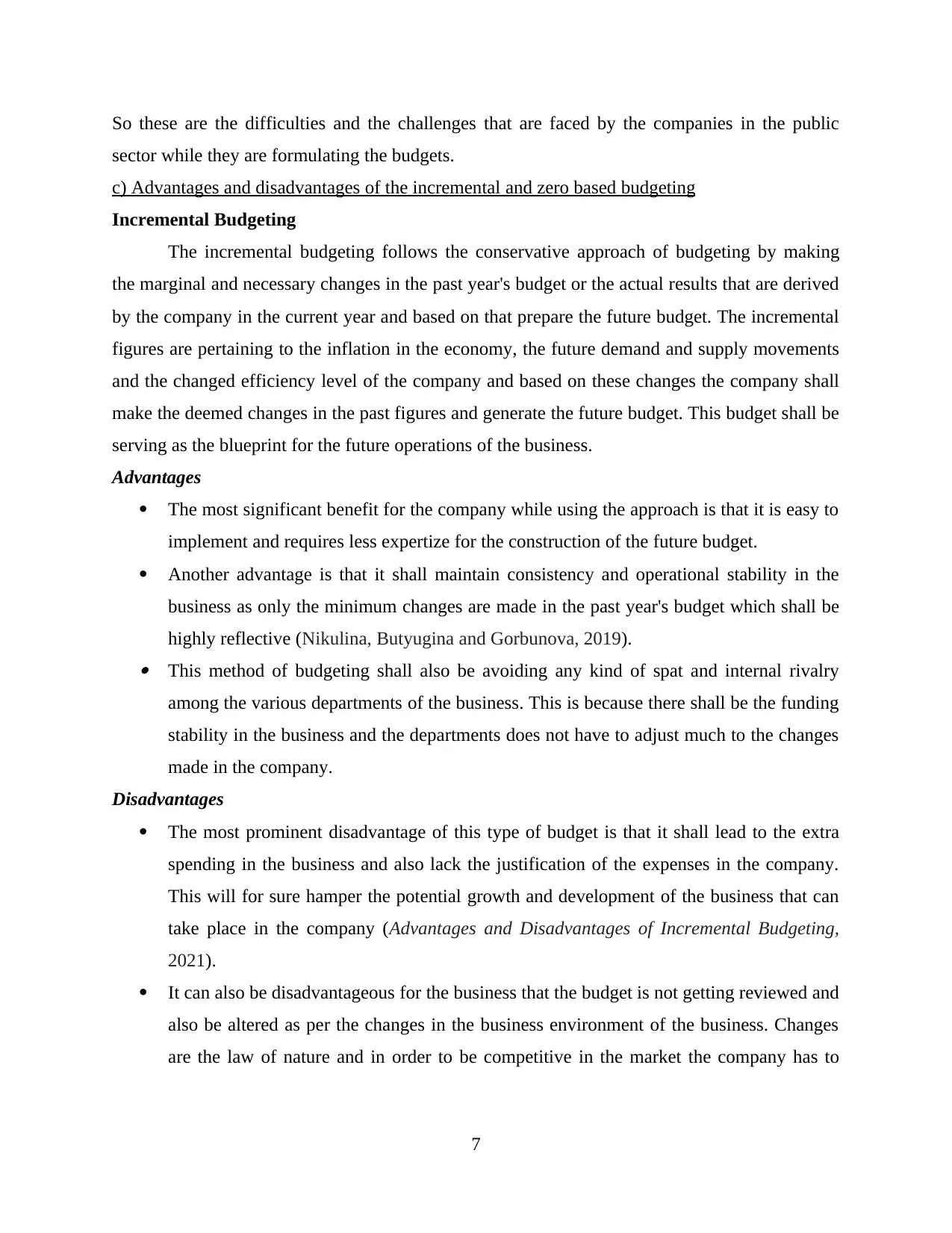
So these are the difficulties and the challenges that are faced by the companies in the public
sector while they are formulating the budgets.
c) Advantages and disadvantages of the incremental and zero based budgeting
Incremental Budgeting
The incremental budgeting follows the conservative approach of budgeting by making
the marginal and necessary changes in the past year's budget or the actual results that are derived
by the company in the current year and based on that prepare the future budget. The incremental
figures are pertaining to the inflation in the economy, the future demand and supply movements
and the changed efficiency level of the company and based on these changes the company shall
make the deemed changes in the past figures and generate the future budget. This budget shall be
serving as the blueprint for the future operations of the business.
Advantages
The most significant benefit for the company while using the approach is that it is easy to
implement and requires less expertize for the construction of the future budget.
Another advantage is that it shall maintain consistency and operational stability in the
business as only the minimum changes are made in the past year's budget which shall be
highly reflective (Nikulina, Butyugina and Gorbunova, 2019). This method of budgeting shall also be avoiding any kind of spat and internal rivalry
among the various departments of the business. This is because there shall be the funding
stability in the business and the departments does not have to adjust much to the changes
made in the company.
Disadvantages
The most prominent disadvantage of this type of budget is that it shall lead to the extra
spending in the business and also lack the justification of the expenses in the company.
This will for sure hamper the potential growth and development of the business that can
take place in the company (Advantages and Disadvantages of Incremental Budgeting,
2021).
It can also be disadvantageous for the business that the budget is not getting reviewed and
also be altered as per the changes in the business environment of the business. Changes
are the law of nature and in order to be competitive in the market the company has to
7
sector while they are formulating the budgets.
c) Advantages and disadvantages of the incremental and zero based budgeting
Incremental Budgeting
The incremental budgeting follows the conservative approach of budgeting by making
the marginal and necessary changes in the past year's budget or the actual results that are derived
by the company in the current year and based on that prepare the future budget. The incremental
figures are pertaining to the inflation in the economy, the future demand and supply movements
and the changed efficiency level of the company and based on these changes the company shall
make the deemed changes in the past figures and generate the future budget. This budget shall be
serving as the blueprint for the future operations of the business.
Advantages
The most significant benefit for the company while using the approach is that it is easy to
implement and requires less expertize for the construction of the future budget.
Another advantage is that it shall maintain consistency and operational stability in the
business as only the minimum changes are made in the past year's budget which shall be
highly reflective (Nikulina, Butyugina and Gorbunova, 2019). This method of budgeting shall also be avoiding any kind of spat and internal rivalry
among the various departments of the business. This is because there shall be the funding
stability in the business and the departments does not have to adjust much to the changes
made in the company.
Disadvantages
The most prominent disadvantage of this type of budget is that it shall lead to the extra
spending in the business and also lack the justification of the expenses in the company.
This will for sure hamper the potential growth and development of the business that can
take place in the company (Advantages and Disadvantages of Incremental Budgeting,
2021).
It can also be disadvantageous for the business that the budget is not getting reviewed and
also be altered as per the changes in the business environment of the business. Changes
are the law of nature and in order to be competitive in the market the company has to
7
⊘ This is a preview!⊘
Do you want full access?
Subscribe today to unlock all pages.

Trusted by 1+ million students worldwide
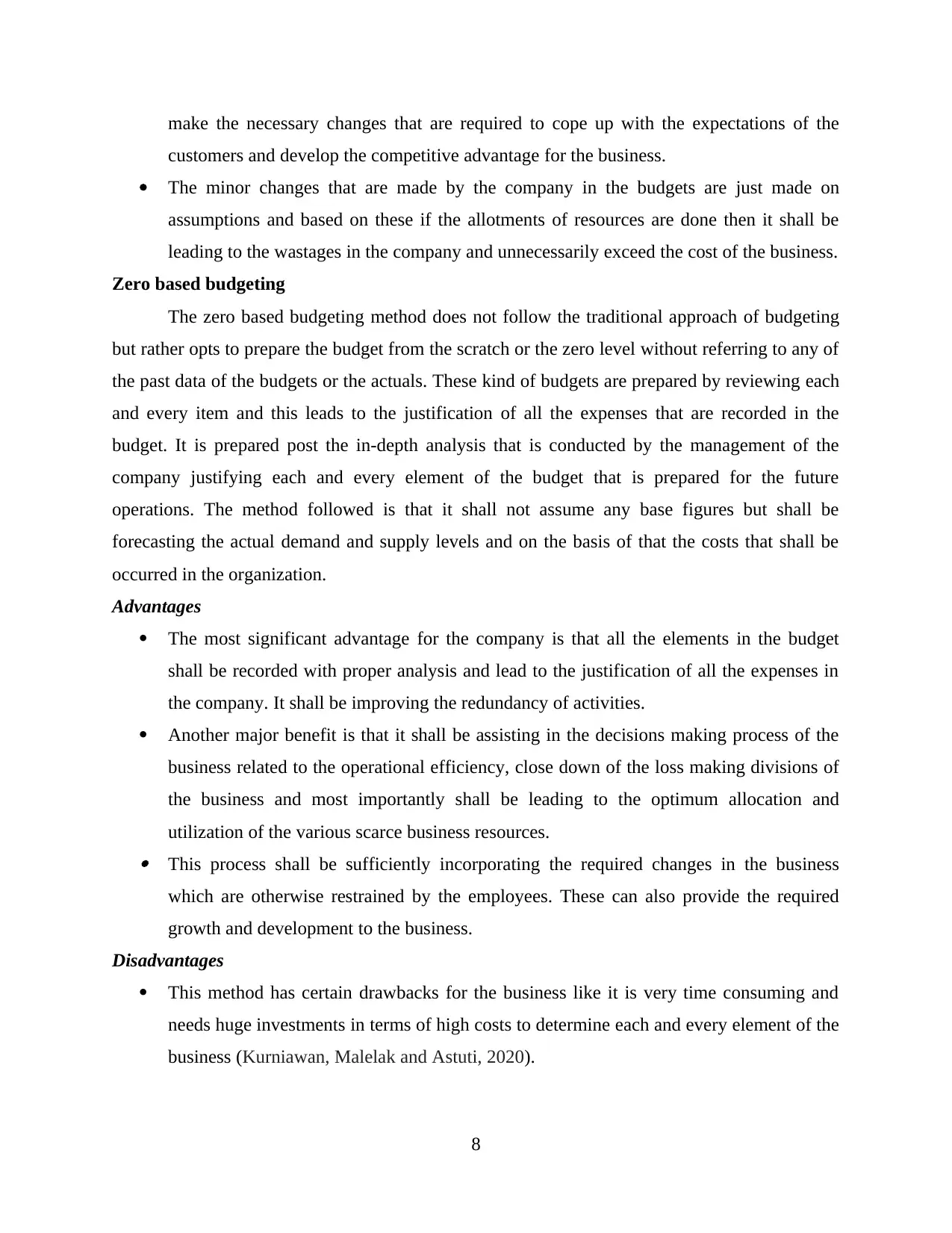
make the necessary changes that are required to cope up with the expectations of the
customers and develop the competitive advantage for the business.
The minor changes that are made by the company in the budgets are just made on
assumptions and based on these if the allotments of resources are done then it shall be
leading to the wastages in the company and unnecessarily exceed the cost of the business.
Zero based budgeting
The zero based budgeting method does not follow the traditional approach of budgeting
but rather opts to prepare the budget from the scratch or the zero level without referring to any of
the past data of the budgets or the actuals. These kind of budgets are prepared by reviewing each
and every item and this leads to the justification of all the expenses that are recorded in the
budget. It is prepared post the in-depth analysis that is conducted by the management of the
company justifying each and every element of the budget that is prepared for the future
operations. The method followed is that it shall not assume any base figures but shall be
forecasting the actual demand and supply levels and on the basis of that the costs that shall be
occurred in the organization.
Advantages
The most significant advantage for the company is that all the elements in the budget
shall be recorded with proper analysis and lead to the justification of all the expenses in
the company. It shall be improving the redundancy of activities.
Another major benefit is that it shall be assisting in the decisions making process of the
business related to the operational efficiency, close down of the loss making divisions of
the business and most importantly shall be leading to the optimum allocation and
utilization of the various scarce business resources. This process shall be sufficiently incorporating the required changes in the business
which are otherwise restrained by the employees. These can also provide the required
growth and development to the business.
Disadvantages
This method has certain drawbacks for the business like it is very time consuming and
needs huge investments in terms of high costs to determine each and every element of the
business (Kurniawan, Malelak and Astuti, 2020).
8
customers and develop the competitive advantage for the business.
The minor changes that are made by the company in the budgets are just made on
assumptions and based on these if the allotments of resources are done then it shall be
leading to the wastages in the company and unnecessarily exceed the cost of the business.
Zero based budgeting
The zero based budgeting method does not follow the traditional approach of budgeting
but rather opts to prepare the budget from the scratch or the zero level without referring to any of
the past data of the budgets or the actuals. These kind of budgets are prepared by reviewing each
and every item and this leads to the justification of all the expenses that are recorded in the
budget. It is prepared post the in-depth analysis that is conducted by the management of the
company justifying each and every element of the budget that is prepared for the future
operations. The method followed is that it shall not assume any base figures but shall be
forecasting the actual demand and supply levels and on the basis of that the costs that shall be
occurred in the organization.
Advantages
The most significant advantage for the company is that all the elements in the budget
shall be recorded with proper analysis and lead to the justification of all the expenses in
the company. It shall be improving the redundancy of activities.
Another major benefit is that it shall be assisting in the decisions making process of the
business related to the operational efficiency, close down of the loss making divisions of
the business and most importantly shall be leading to the optimum allocation and
utilization of the various scarce business resources. This process shall be sufficiently incorporating the required changes in the business
which are otherwise restrained by the employees. These can also provide the required
growth and development to the business.
Disadvantages
This method has certain drawbacks for the business like it is very time consuming and
needs huge investments in terms of high costs to determine each and every element of the
business (Kurniawan, Malelak and Astuti, 2020).
8
Paraphrase This Document
Need a fresh take? Get an instant paraphrase of this document with our AI Paraphraser
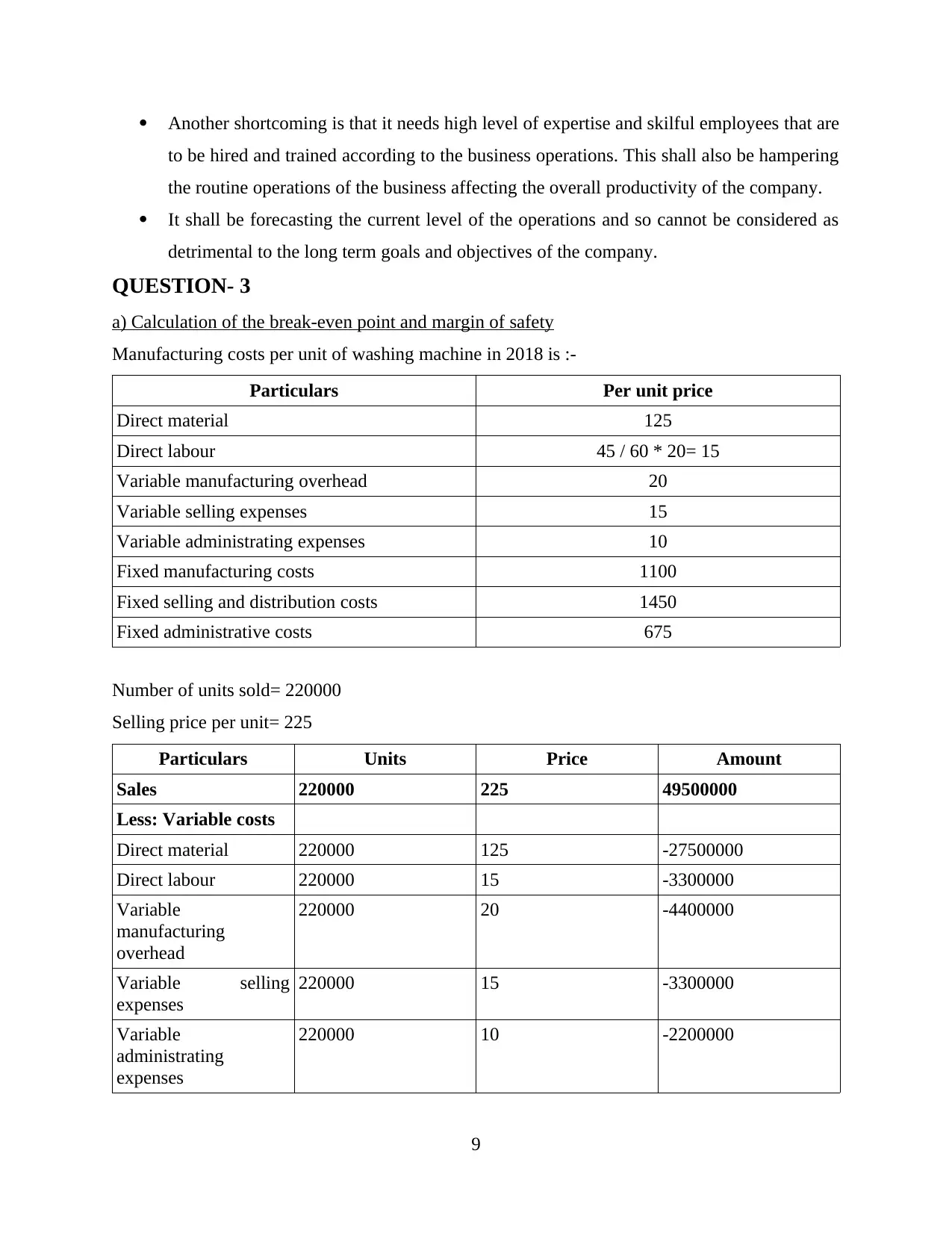
Another shortcoming is that it needs high level of expertise and skilful employees that are
to be hired and trained according to the business operations. This shall also be hampering
the routine operations of the business affecting the overall productivity of the company.
It shall be forecasting the current level of the operations and so cannot be considered as
detrimental to the long term goals and objectives of the company.
QUESTION- 3
a) Calculation of the break-even point and margin of safety
Manufacturing costs per unit of washing machine in 2018 is :-
Particulars Per unit price
Direct material 125
Direct labour 45 / 60 * 20= 15
Variable manufacturing overhead 20
Variable selling expenses 15
Variable administrating expenses 10
Fixed manufacturing costs 1100
Fixed selling and distribution costs 1450
Fixed administrative costs 675
Number of units sold= 220000
Selling price per unit= 225
Particulars Units Price Amount
Sales 220000 225 49500000
Less: Variable costs
Direct material 220000 125 -27500000
Direct labour 220000 15 -3300000
Variable
manufacturing
overhead
220000 20 -4400000
Variable selling
expenses
220000 15 -3300000
Variable
administrating
expenses
220000 10 -2200000
9
to be hired and trained according to the business operations. This shall also be hampering
the routine operations of the business affecting the overall productivity of the company.
It shall be forecasting the current level of the operations and so cannot be considered as
detrimental to the long term goals and objectives of the company.
QUESTION- 3
a) Calculation of the break-even point and margin of safety
Manufacturing costs per unit of washing machine in 2018 is :-
Particulars Per unit price
Direct material 125
Direct labour 45 / 60 * 20= 15
Variable manufacturing overhead 20
Variable selling expenses 15
Variable administrating expenses 10
Fixed manufacturing costs 1100
Fixed selling and distribution costs 1450
Fixed administrative costs 675
Number of units sold= 220000
Selling price per unit= 225
Particulars Units Price Amount
Sales 220000 225 49500000
Less: Variable costs
Direct material 220000 125 -27500000
Direct labour 220000 15 -3300000
Variable
manufacturing
overhead
220000 20 -4400000
Variable selling
expenses
220000 15 -3300000
Variable
administrating
expenses
220000 10 -2200000
9
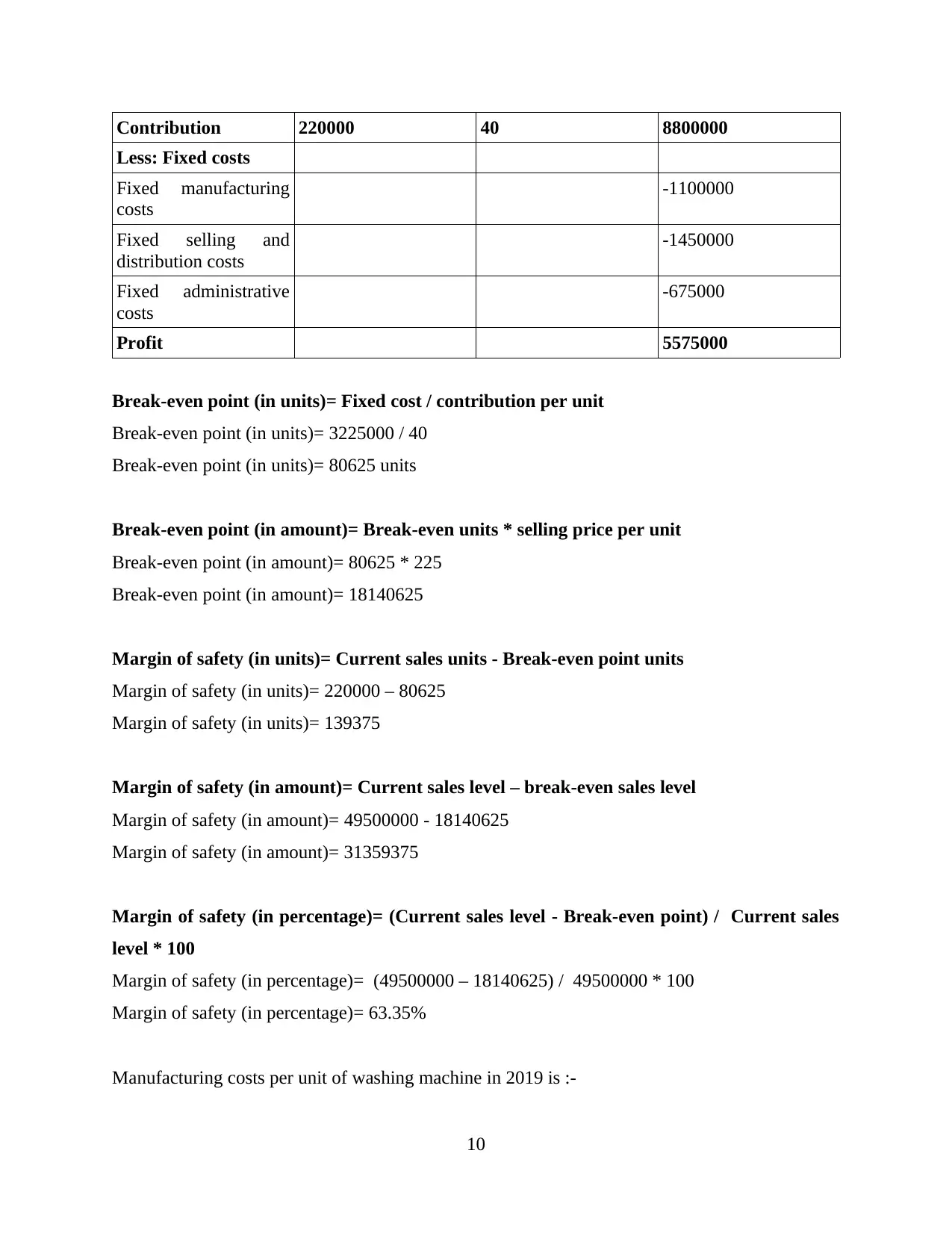
Contribution 220000 40 8800000
Less: Fixed costs
Fixed manufacturing
costs
-1100000
Fixed selling and
distribution costs
-1450000
Fixed administrative
costs
-675000
Profit 5575000
Break-even point (in units)= Fixed cost / contribution per unit
Break-even point (in units)= 3225000 / 40
Break-even point (in units)= 80625 units
Break-even point (in amount)= Break-even units * selling price per unit
Break-even point (in amount)= 80625 * 225
Break-even point (in amount)= 18140625
Margin of safety (in units)= Current sales units - Break-even point units
Margin of safety (in units)= 220000 – 80625
Margin of safety (in units)= 139375
Margin of safety (in amount)= Current sales level – break-even sales level
Margin of safety (in amount)= 49500000 - 18140625
Margin of safety (in amount)= 31359375
Margin of safety (in percentage)= (Current sales level - Break-even point) / Current sales
level * 100
Margin of safety (in percentage)= (49500000 – 18140625) / 49500000 * 100
Margin of safety (in percentage)= 63.35%
Manufacturing costs per unit of washing machine in 2019 is :-
10
Less: Fixed costs
Fixed manufacturing
costs
-1100000
Fixed selling and
distribution costs
-1450000
Fixed administrative
costs
-675000
Profit 5575000
Break-even point (in units)= Fixed cost / contribution per unit
Break-even point (in units)= 3225000 / 40
Break-even point (in units)= 80625 units
Break-even point (in amount)= Break-even units * selling price per unit
Break-even point (in amount)= 80625 * 225
Break-even point (in amount)= 18140625
Margin of safety (in units)= Current sales units - Break-even point units
Margin of safety (in units)= 220000 – 80625
Margin of safety (in units)= 139375
Margin of safety (in amount)= Current sales level – break-even sales level
Margin of safety (in amount)= 49500000 - 18140625
Margin of safety (in amount)= 31359375
Margin of safety (in percentage)= (Current sales level - Break-even point) / Current sales
level * 100
Margin of safety (in percentage)= (49500000 – 18140625) / 49500000 * 100
Margin of safety (in percentage)= 63.35%
Manufacturing costs per unit of washing machine in 2019 is :-
10
⊘ This is a preview!⊘
Do you want full access?
Subscribe today to unlock all pages.

Trusted by 1+ million students worldwide
1 out of 17
Related Documents
Your All-in-One AI-Powered Toolkit for Academic Success.
+13062052269
info@desklib.com
Available 24*7 on WhatsApp / Email
![[object Object]](/_next/static/media/star-bottom.7253800d.svg)
Unlock your academic potential
Copyright © 2020–2025 A2Z Services. All Rights Reserved. Developed and managed by ZUCOL.



